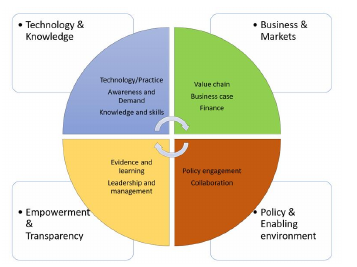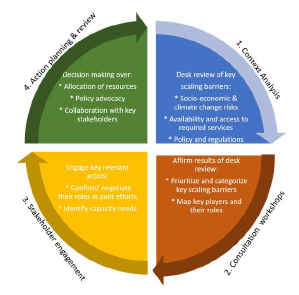Systemic barriers to scaling private sector driven climate-smart agricultural innovations in East Africa’s potato, sesame and common bean value chains
Overview of CRAFT Project
The CRAFT project (2018-2023) promotes a bottom-up market-driven scaling agenda that supports inclusive business models to enhance climate-resilient farming systems through sustainable intensification along selected oilseed, pulse and potato agricultural value chains. The selection criteria for these crops includes sufficient private sector interest and capacity for coinvestment; adequate domestic consumption to drive market development opportunities; and ample evidence of climate change risks projected to face the value chains. Across East Africa, unfavorable climate change patterns involving rising temperatures, increased variability of seasonal rainfall and a higher frequency and intensity of extreme weather events such as droughts and floods are aggravating food insecurity and pose further challenges for rural development.
CRAFT is being implemented by a consortium of five partners: SNV (lead), Wageningen University (WU) and Wageningen Environmental Research (WEnR), the CGIAR Research Program on Climate Change, Agriculture and Food Security (CCAFS), Agriterra and Rabo Bank. The project draws from consortium partners’ past experiences and partnerships with public-private entities in the region to foster dynamic and sustainable private-sector led development in the agriculture sector. Thus far, the project has identified several high-potential Small and Medium Enterprises (SMEs) in the selected value chains whose capacities can be enhanced to help scale up CSA innovations and climate-resilient farming systems in Kenya, Uganda and Tanzania.
Scaling assessment methodology

There are various scaling frameworks, tools and methodologies in the literature that can be used to assess the ‘scaling readiness’ of agricultural development interventions against the background of an intervention context and target audience (see e.g., Sartas et al. 2019). The CRAFT project draws insights from the PPPlab’s Scaling Scan tool to assess scaling barriers facing business champions and relevant actors working in select crop value chains. The CRAFT team assessed that the Scaling Scan adequately covers vital complementary non-technological requirements that highly shape the scalability of any new ‘innovation package’ and offer useful guidance to help projects identify potential enabling factors and barriers to their scaling ambition. The Scaling Scan identities 10 ‘scaling ingredients’ that need to be effectively harnessed for scaling efforts to achieve long-term positive impacts (Jacobs et al. 2018). These were contextualized to respond to CRAFT’s bottom up private sector driven scaling agenda (Figure 1).
This Info Note summarizes the results of scaling assessment work undertaken from June to December 2019 on the potato, sesame and ommon bean value chains in Kenya, Uganda and Tanzania respectively. The list of crops under this initiative include potatoes, green grams, common beans and sorghum in Kenya; soybeans, sesame, sunflower and potato in Uganda; and common beans, sunflower, sorghum and potato in Tanzania. For this initial study on scaling, the author focused on three crops, and developed and applied a four-step (ongoing) scaling methodological strategy to better understand the system dynamics of selected value chains and potential barriers that proposed CSA interventions may face (Figure 2).

Step 1 involves a contextual analysis of the scaling barriers in a specific value chain, entailing a desk review of peer-reviewed and gray literature, as well as project documents from implementing country teams. Step 2 consists of consultation workshops with country teams, one per respective value chain, to engage in further analysis of the identified key scaling barriers and to outline the key players and their roles in helping to resolve them. Here, the options to address these scaling challenges are also prioritized and categorized according to different spheres of influence: a) within individual business cases, b) among several value chain actors and c) at higher system levels of policy and governance.
Scaling barriers that are systemic in nature require engagement or collaboration with relevant external actors. Thus, Step 3 comprises stakeholder engagement with key actors to confirm or negotiate a joint way forward in addressing the identified scaling barriers, and to assess (initial) capacity constraints. Step 4 encompasses action planning and regular review, whereby relevant project players make choices on how to allocate resources, engage in policy advocacy at local and national levels, support collaborative efforts with different stakeholders and periodically review activities. The results presented here come from work undertaken on the first two steps (1-2) of the scaling methodological strategy only and focus its analysis mainly on higher level systemic scaling barriers in the potato, sesame and common bean value chains.
Results
The findings from contextual research analysis and consultation workshops with three project country teams found that although potato, sesame and common beans are commercially viable crops, they face several important systemic barriers that limit the scaling of private-sector driven CSA interventions and uptake of these among rural producers. Among these are challenges associated with developing seed systems that are responsive to farmers’ preferred traits (e.g., yield potential and disease-tolerant) while also addressing market desirability, as is the case with developing seed potato varieties.
Until recently, seed potato breeding and multiplication efforts in Kenya have prioritized traits that can stabilize yields and improve food security, such as early maturity, disease resistant and high yielding, but paid little attention to processing qualities and marketing needs (Kaguongo et al. 2015; Lung’aho and Schulte-Geldermann 2016). Thus, whereas over 60 potato varieties have been commercially released in the country, only a few of these are widely distributed (NPCK 2019; FAO 2013). Among the most popular varieties are ‘Shangi’, ‘Dutch Robjin’, and ‘Unica’ due to certain preferred characteristics by growers such as yield potential, disease-tolerance and market demand. The ‘Dutch Robjin’, which is evidently the only released variety in Kenya with superior attributes for processing internationally acceptable chips and crisps, has a high market demand and is popular among growers, particularly those with an assured market (Kaguongo et al. 2015). However, this variety is highly susceptible to dis-
ease and pests and is low yielding. Growers are often forced to apply large amounts of chemical fertilizers and pesticides to manage pests and diseases, which burdens producers with additional costs and is not climate-smart.
Another important systemic barrier facing the three value chains is unreliable market systems that do not guarantee reliable prices for producers, which contribute to irregular quality and quantity of produce. All three crops are primarily grown by smallholder farmers under rainfed conditions who experience glut and lean times and price fluctuations. Further, marketing of the crops is often characterized by numerous transactions involving small volumes, and many traders with variable capacities, as is the case of sesame in Uganda (LTS International 2017). The result is often low profit margins for producers, emanating from high transaction costs associated with multiple market intermediaries who aggregate small volumes of produce scattered among numerous small-scale producers. In Uganda, fragmented traders are evidently unable to effectively coordinate and provide timely market intelligence to growers on sesame quality demand and prices, which can have a positive impact of the competitiveness of the crop and potentially help move sesame with ease in both domestic and international markets (Munyua et al. 2013).
Whereas East African countries have achieved impressive records on financial inclusion over the last decade, fueled in part by the growth of mobile money utilization, formal financial services remain out of reach for numerous smallholder farmers and the SMEs serving them, including traders who aggregate produce and other value chain actors. Inclusive financial services can provide much needed working capital for farmers to gain access to improved CSA inputs and services as well as allow market intermediaries to pay smallholder farmers for their grain in a timely fashion. In Tanzania, for instance, a majority of small-scale agricultural producers and SMEs in the common bean value chain remain underserved due to stringent collateral security requirements and high interest rates on one hand and limited assets and insufficient accounting and financial recording practices on the other. In that context, an important source of credit for most rural households are Savings and Credit Cooperatives Societies (SACCOs), run by farmer (or community) associations and generally offering more competitive interest rates compared to formal micro-finance institutions. Some SACCOs also act as a form of social capital where members can access important agricultural extension information.
Concluding remarks and next steps
The scalability of new innovations is highly contingent upon the smooth functioning of complementary services and activities within a particular context. Overall, effective scaling requires a deep understanding of the socio-economic and geographical context in question in order to apply an innovation well; linking beneficiaries to the finances required; and collaborating with relevant policy and institutional actors to harness additional support and resources, etc. Where barriers or bottlenecks exist at any stage of a value chain (e.g., counterfeit inputs, price volatility and high interest rates on loans), the scaling process will likely be restricted. Thus, dedicated work to properly understand systemic constraints is a critical first step to developing realistic scaling strategies. Flexibility in project design and implementation is also essential to deliver innovations that answer to local conditions and work within the confines of wider systems, i.e., agricultural sectors of countries. Such wider systems are often driven by a diversity of actors (and their interests) who create the (dis)enabling environment for innovations to go to scale (Woltering et al. 2019).
In the case of the potato, sesame and common bean value chains examined here, the effective scaling of private-sector driven CSA interventions requires strong collaboration with the public sector as well as other relevant actors to bring about incremental structural improvements and to strengthen the institutional environment for effective implementation. Indeed, one of CRAFT’s core objectives is to support policy efforts to address the most significant institutional and socio-economic barriers for large-scale CSA interventions. In Kenya’s potato value chain, for instance, public-private sector breeding and multiplication efforts can promote seed potato varieties that respond to variations in farmers preferences, market dynamics and climate change while raising awareness around such varieties.
In the area of increasing access to credit, private sector driven CSA interventions can liaise with agriculture-sector friendly financial institutions to improve their lending conditions and requirements for clients and to embrace financial inclusion. There is however also a need to provide greater economic support to SACCOs, including strengthening their capacities to train their members in financial management and lending.
The last two-steps of CRAFT’s Scaling Methodological Strategy aim to contribute to policy engagement and multi-stakeholder dialogues to overcome systemic scaling barriers in select value chains. This work will comprise key stakeholder interviews and meetings with key actors from relevant government ministries and agencies and other institutional players in the three countries in the near future. The anticipated outcome of these interactions is a joint strategy to address the identified scaling barriers.